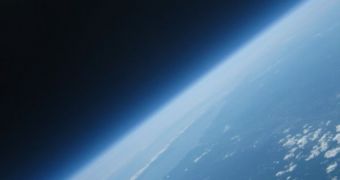In a constantly expanding trend, the Do-It-Yourself (DIY) mentality is currently making its way in many walks of life, from Google's servers to people making their own clothes. Just recently, two students from the Massachusetts Institute of Technology (MIT) have proven that they can compete with NASA in terms of video equipment, when they have designed a space-observing system that uses off-the-shelf parts and costs just some $150 dollars. To prove their concept, they have also launched it aboard a balloon to the upper atmosphere, where it has snapped amazing photos of its surroundings, Wired reports.
The entire rig was made up of a helium-filled weather balloon, a styrofoam beer cooler, a cheap Canon A470 compact camera, and instant hand warmers to keep everything warm enough to operate. Through their apparatus, the two students, Justin Lee and Oliver Yeh, proved that rockets, boosters and expensive control systems were not necessary for photographing the curvature of the Earth. They also proved that scientifically valuable images could be taken with a total cost of $148, including duct tape.
The ensemble was also equipped with a GPS cellphone, so that the two would know where the balloon was going to land, after having successfully completed its mission. The instrument was launched on September 2nd, at 11:45 am local time, from Sturbridge, Massachusetts. The location was chosen because the campus experienced prevailing winds that would have taken the balloon out into the Atlantic ocean. The two also used the University of Wisconsin’s balloon-trajectory website to gain a better clue of where their rig was going to land on descent.
The camera that Yeh and Lee sent to the upper atmosphere was upgraded with the CHDK (Canon Hacker’s Development Kit) open-source firmware, which opens up many new features for these devices. A timer was set to shoot pictures every five seconds, and an 8 Gb card was added to the camera. This was enough to hold almost all of the pictures taken during the eight-hour flight. The image accompanying this article, for instance, was taken at 93,000 feet, some 18 miles high. The two MIT students say that they will share a step-by-step tutorial on how they managed their performance, and that they will make it available to everyone for free.

 14 DAY TRIAL //
14 DAY TRIAL //